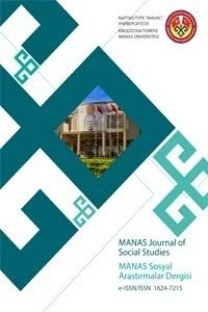ÖĞRENCİLERİN POWERPOİNT ETKİLİLİĞE DAİR ALGILARI ÖLÇEĞİNİN GEÇERLİK VE GÜVENİRLİK ÇALIİMASI
VALIDITY AND RELIABILITY OF STUDENT PERCEPTIONS OF POWERPOINT EFFICACY SCALE
___
- Atkinson, C., & Mayer, R. E. (2004). Five Ways To Reduce PowerPoint Overload. Retrieved from Https://Www.İndezine.Com/Stuff/Atkinsonmaye.Pdf.
- Baker, J. P., Goodboy, A. K., Bowman, N. D., & Wright, A. A. (2018). Does Teaching With PowerPoint Increase Students' Learning? A Meta-Analysis. Computers & Education, 126, 376-387.
- Burke, L. A., & James, K. E. (2008). PowerPoint-Based Lectures in Business Education: An Empirical Investigation of Student-Perceived Novelty and Effectiveness. Business Communication Quarterly, 71(3), 277-296.
- Craig, R. J., & Amernic, J. H. (2006). PowerPoint Presentation Technology And The Dynamics Of Teaching. Innovative Higher Education, 31(3), 147–160. Https://Doi.Org/10.1007/S10755-006-9017-5
- Creswell, J. W. (2012). Educational Research: Planning, Conducting, and Evaluating Quantitative And Qualitative Research (4th Ed.). Upper Saddle River, NJ: Pearson Education.
- Çokluk, Ö., Şekercioğlu, G., & Büyüköztürk, Ş. (2010). Sosyal Bilimler için Çok Değişkenli İstatistik [MultivarŞAte Statistics for SocŞAl Sciences]. Ankara, Pegem Yayıncılık.
- Fritschi, J. (2008). Examining Pre-Service Instructors’ Use of PowerPoint Based on Pre-Service Students’ Perceptions: A Mixed Methods Study (Unpublished Doctoral Dissertation). The University of Alabama at Birmingham.
- George, D., & Mallery, P. (2010). SPSS for Windows Step By Step: A Simple Guide and Reference 18.0 Update. Prentice Hall Press Upper Saddle River, NJ, USA.
- Guilford, J. P. (1954). Psychometric Methods (2th Ed). New York: Mcgraw-Hill.
- Hair, J. F., Black, W. C., Tatham, R. L., & Anderson, R. E. (2014). MultivarŞAte Data Analysis: Pearson New International Edition (7th Ed.). NJ: Pearson/Prentice Hall.
- Hartnett, N., Römcke, J., & Yap, C. (2003). Recognizing the Importance of Instruction Style to Students' Performance: Some Observations from Laboratory Research–A Research Note. Accounting Education, 12(3), 313-331.
- Hertz, B., Van Woerkum, C., & Kerkhof, P. (2015). Why Do Scholars Use PowerPoint The Way They Do?. Business and Professional Communication Quarterly, 78(3), 273-291.
- Hill, A., Arford, T., Lubitow, A., & Smollin, L. M. (2012). “I’m Ambivalent about It”: The Dilemmas Of PowerPoint. Teaching Sociology, 40(3), 242-256.
- Hopper, K. B., & Waugh, J. B. (2014). PowerPoint: An Overused Technology Deserving Of Criticism, But Indispensable. Educational Technology, 29-34.
- Jordan, L. A., & Papp, R. (2014). PowerPoint®: It’s Not Yes Or No – It’s When and How. Research in Higher Education Journal, 22, 1–11.
- Kline, R. B. (2015). Principles and Practice of Structural Equation Modeling. Guilford Publications.
- Kosslyn, S. M., & Kievit, R. A., Russell, A. G., & Shephard, J. M. (2012). PowerPoint® Presentation Flaws And Failures: A Psychological Analysis. Frontiers in Psychology. Https://Doi.Org/10.3389/Fpsyg.2012.00230
- Levasseur, D. G., & Sawyer, K. (2006). Pedagogy Meets PowerPoint: A Research Review of the Effects of Computer-Generated Slides in the Classroom. The Review of Communication, 6(1-2), 101-123.
- Maccallum, R. C., Widaman, K. F., Zhang, S., & Hong, S. (1999). Sample Size in Factor Analysis. Psychological Methods, 4(1), 84–99. Https://Doi.Org/10.1037/1082-989X.4.1.84
- Mayer, R. E. (2009). MultimedŞA Learning (2 Edition). New York, USA: Cambridge University Press.
- Moulton, S. T., Türkay, S., & Kosslyn, S. M. (2017). Does A Presentation’s Medium Affect Its Message? Powerpoint, Prezi, and Oral Presentations. Plos One, 12(7), E0178774.
- Nouri, H., & Shahid, A. (2005). The Effect of PowerPoint Presentations on Student Learning and Attitudes. Global Perspectives on Accounting Education, 2, 53.
- Nowaczyk, R. H., Santos, L. T., & Patton, C. (1998). Student Perception of MultimedŞA in the Undergraduate Classroom. International Journal of Instructional MedŞA, 25(4), 367.
- Nunnally, J. C. (1978). Psychometric Theory. New York: Mcgraw-Hill.
- Raykov, T., & Marcoulides, G. A. (2008). An Introduction to Applied MultivarŞAte Analysis. New York: Taylor and Francis.
- Roblyer, M. D., & Doering, A. H. (2012). Integrating Educational Technology into Teaching (6th Ed.). Allyn & Bacon.
- Shwom, B. L., & Keller, K. P. (2003). The Great Man Has Spoken. Now What Do I Do? A Response to Edward R. Tufte’s. The Cognitive Style of PowerPoint. Communication Insight, 1(1), 2–16.
- Stevens, J. (2009). Applied MultivarŞAte Statistics for the SocŞAl Sciences (5th Ed.). NJ: Lawrence Erlbaum AssocŞAtes.
- Susskind, J. E. (2005). PowerPoint’s Power in the Classroom: Enhancing Students’ Self-Efficacy and Attitudes. Computers & Education, 45(2), 203–215.
- Sümer, N. (2000). Yapısal Eşitlik Modelleri: Temel Kavramlar ve Örnek Uygulamalar [Structural Equation Modeling: Basic Concepts and Applications]. Türk Psikoloji Yazıları, 3(6), 74-79.
- Tufte, E. R. (2003). The Cognitive Style of PowerPoint. Cheshire, CT: Graphics Press.
- Wecker, C. (2012). Slide Presentations as Speech Suppressors: When and Why Learners Miss Oral Information. Computers & Education, 59(2), 260-273.
- Yilmazel-Sahin, Y. (2009). A Comparison of Graduate and Undergraduate Teacher Education Students' Perceptions of Their Instructors' Use Of Microsoft PowerPoint. Technology, Pedagogy and Education, 18(3), 361-380.
- ISSN: 1694-7215
- Yayın Aralığı: Yılda 4 Sayı
- Başlangıç: 2001
- Yayıncı: KIRGIZİSTAN-TÜRKİYE MANAS ÜNİVERSİTESİ
FARKLI BRANİLARDAKİ ALTYAPI SPORCULARININ SOMATOTİP ÖZELLİKLERİNİN KARİILAİTIRILMASI
Ercüment ERDOĞAN, İbrahim Can NEFESOĞLU, Cihan GÜRBÜZ
GRİ PAZARLAMA VE PARALEL İTHALAT ÜZERİNE BİR ARAŞTIRMA
MERHAMET EĞİTİMİ PROGRAMININ ÜNİVERSİTE ÖĞRENCİLERİNİN MERHAMETLİ OLMA DÜZEYLERİNE ETKİSİ
REALİST RUS EDEBİYATINDAN ERKEN DÖNEM SOVYET SİNEMASINA GERÇEKÇİ MEKÂN KULLANIMI
ETKİN DEVLET PERSPEKTİFİNDEN KOSGEB MARKALAŞMA VE KURUMSALLAŞMA PROGRAMININ İNCELENMESİ
Ali AYCI, Dilek DEMİRBAŞ, Safa DEMİRBAŞ
ÖĞRENCİLERİN POWERPOİNT ETKİLİLİĞE DAİR ALGILARI ÖLÇEĞİNİN GEÇERLİK VE GÜVENİRLİK ÇALIİMASI
Ahmet Murat UZUN, Selcan KİLİS
AHMET KARA, Ahmet ALTINOK, CENGİZ ŞAHİN
Nuri ERDEMİR, EZGİ SUMBAS, Zeynep UMUR ERKUŞ, Hulisi GENÇ, Aslı TUNCA
SOSYAL BİLGİLER ÖĞRETMEN ADAYLARININ DİJİTAL VATANDAİLIK GÖSTERGELERİNİN İNCELENMESİ
